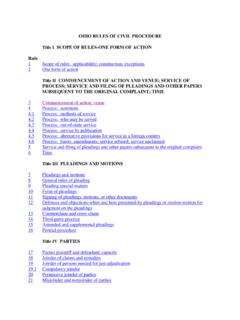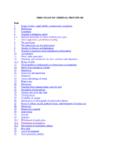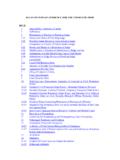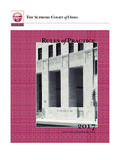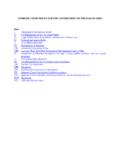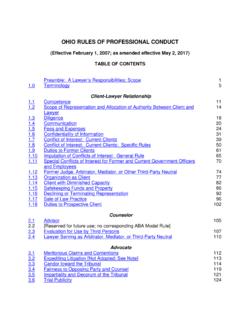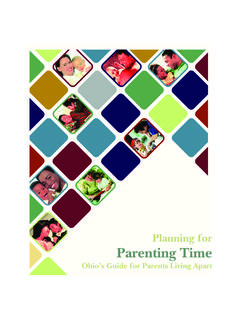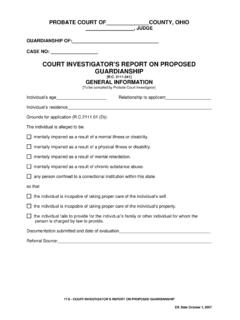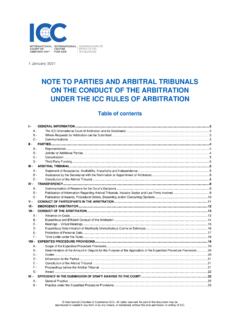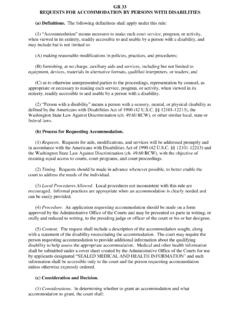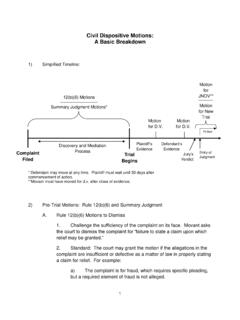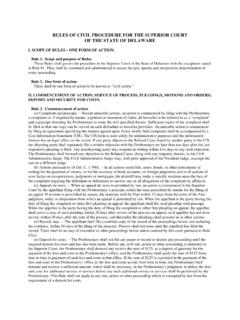Transcription of Ohio Rules of Appellate Procedure - Supreme Court of Ohio
1 ohio Rules OF Appellate Procedure Title I APPLICABILITY OF Rules Rule 1 Scope of Rules 2 Law and fact appeals abolished Title II APPEALS FROM JUDGMENTS AND ORDERS OF Court OF RECORD 3 Appeal as of right-how taken 4 Appeal as of right-when taken 5 Appeals by leave of Court 6 Concurrent jurisdiction in criminal actions 7 Stay or injunction pending appeal-civil and juvenile actions 8 Bail and suspension of execution of sentence in criminal cases 9 The record on appeal 10 Transmission of the record 11 Docketing the appeal; filing of the record Accelerated calendar Expedited appeals 12 Determination and judgment on appeal Title III GENERAL PROVISIONS 13 Filing and service 14 Computation and extension of time 15 Motions 16 Briefs 17 Brief of an amicus curiae 18 Filing and service of briefs 19 Form of briefs and other papers 20 Prehearing conference 21 Oral argument 22 Entry of judgment 23 Damages of delay 24 Costs 25 Motion to certify a conflict 26 Application for reconsideration; application for en banc consideration; application for reopening 27 Execution, mandate 28 Voluntary dismissal 29 Substitution of parties Rule 30 Duties of clerks 31 [Reserved] 32 [Reserved] 33 [Reserved] 34 Appointment of magistrates 41 Rules of courts of appeals 42 Title 43 Effective date APPENDIX OF FORMS TITLE I.
2 APPLICABILITY OF Rules RULE 1. Scope of Rules (A) These Rules govern Procedure in appeals to courts of appeals from the trial courts of record in ohio . (B) Procedure in appeals to courts of appeals from the board of tax appeals shall be as provided by law, except that App. R. 13 to 33 shall be applicable to those appeals. (C) Procedures in appeals to courts of appeals from juvenile courts pursuant to section of the Revised Code shall be as provided by that section, except that these Rules govern to the extent that the Rules do not conflict with that section. [Effective: July 1, 1971; amended effective July 1, 1994.] RULE 2. Law and Fact Appeals Abolished Appeals on questions of law and fact are abolished. [Effective: July 1, 1971.] TITLE II. APPEALS FROM JUDGMENTS AND ORDERS OF Court OF RECORD RULE 3.
3 Appeal as of Right - How Taken (A) Filing the notice of appeal. An appeal as of right shall be taken by filing a notice of appeal with the clerk of the trial Court within the time allowed by Rule 4. Failure of an appellant to take any step other than the timely filing of a notice of appeal does not affect the validity of the appeal, but is ground only for such action as the Court of appeals deems appropriate, which may include dismissal of the appeal. Appeals by leave of Court shall be taken in the manner prescribed by Rule 5. (B) Joint or consolidated appeals. If two or more persons are entitled to appeal from a judgment or order of a trial Court and their interests are such as to make joinder practicable, they may file a joint notice of appeal, or may join in appeal after filing separate timely notices of appeal, and they may thereafter proceed on appeal as a single appellant.
4 Appeals may be consolidated by order of the Court of appeals upon its own motion or upon motion of a party, or by stipulation of the parties to the several appeals. (C) Cross appeal. (1) Cross appeal required. A person who intends to defend a judgment or order against an appeal taken by an appellant and who also seeks to change the judgment or order or, in the event the judgment or order may be reversed or modified, an interlocutory ruling merged into the judgment or order, shall file a notice of cross appeal within the time allowed by 4. (2) Cross appeal and cross-assignment of error not required. A person who intends to defend a judgment or order appealed by an appellant on a ground other than that relied on by the trial Court but who does not seek to change the judgment or order is not required to file a notice of cross appeal or to raise a cross-assignment of error.
5 (D) Content of the notice of appeal. The notice of appeal shall specify the party or parties taking the appeal; shall designate the judgment, order or part thereof apealed from; and shall name the Court to which the appeal is taken. The title of the case shall be the same as in the trial Court with the designation of the appellant added, as appropriate. Form 1 in the Appendix of Forms is a suggested form of a notice of appeal. (E) Service of the notice of appeal. The clerk of the trial Court shall serve notice of the filing of a notice of appeal and, where required by local rule, a docketing statement, by mailing, or by facsimile transmission, a copy to counsel of record of each party other than the appellant, or, if a party is not represented by counsel, to the party at the party's last known address.
6 The clerk shall mail or otherwise forward a copy of the notice of appeal and of the docket entries, together with a copy of all filings by appellant pursuant to 9(B), to the clerk of the Court of appeals named in the notice. The clerk shall note on each copy served the date on which the notice of appeal was filed. Failure of the clerk to serve notice shall not affect the validity of the appeal. Service shall be sufficient notwithstanding the death of a party or a party's counsel. The clerk shall note in the docket the names of the parties served, the date served, and the means of service. (F) Amendment of the notice of appeal. (1) When leave required. A party may amend a notice of appeal without leave if the time to appeal from the order that was the subject of the initial notice of appeal has not yet lapsed under 4.
7 Thereafter, the Court of appeals within its discretion and upon such terms as are just may allow the amendment of a notice of appeal, so long as the amendment does not seek to appeal from a trial Court order beyond the time requirements of 4. (2) Where filed. An amended notice of appeal shall be filed in both the trial Court and the Court of appeals. (G) Docketing statement (1) If a Court of appeals has adopted an accelerated calendar by local rule pursuant to Rule , the appellant shall file a docketing statement with the Clerk of the trial Court with the notice of appeal. (See Form 2, Appendix of Forms.) The purpose of the docketing statement is to determine whether an appeal will be assigned to the accelerated or the regular calendar. A case may be assigned to the accelerated calendar if any of the following apply: (a) No transcript is required ( , summary judgment or judgment on the pleadings); (b) The length of the transcript is such that its preparation time will not be a source of delay; (c) An agreed statement is submitted in lieu of the record; (d) The record was made in an administrative hearing and filed with the trial Court ; (e) All parties to the appeal approve an assignment of the appeal to the accelerated calendar; or (f) The case has been designated by local rule for the accelerated calendar.
8 The Court of appeals by local rule may assign a case to the accelerated calendar at any stage of the proceeding. The Court of appeals may provide by local rule for an oral hearing before a full panel in order to assist it in determining whether the appeal should be assigned to the accelerated calendar. Upon motion of appellant or appellee for a procedural order pursuant to 15(B) filed within seven days after the notice of appeal is filed with the clerk of the trial Court , a case may be removed for good cause from the accelerated calendar and assigned to the regular calendar. Demonstration of a unique issue of law which will be of substantial precedential value in the determination of similar cases will ordinarily be good cause for transfer to the regular calendar.
9 (2) If the appeal is expedited under , the appellant shall file a docketing statement with the clerk of the trial Court with the notice of appeal indicating the category of case under and the need for priority disposition. [Effective: July 1, 1971; amended effective July 1, 1972; July 1, 1977; July 1, 1982; July 1, 1991; July 1, 1992; July 1, 1994; July 1, 2013; July 1, 2015.] Staff Note (July 1, 2015 amendment) 3(G) is amended by adding a new subsection requiring appellants in expedited cases under to file a docketing statement with the notice of appeal, in order to alert the Appellate Court to the need for priority disposition. Staff Notes (July 1, 2013 Amendments) 3(C)(2) is amended to clarify that a party seeking to defend a judgment on a ground other than that relied on by the trial Court need not file a cross-assignment of error to do so; instead, that party may simply raise the arguments in the Appellate brief.
10 The prior rule suggested as much, but some courts, relying on , have refused to consider arguments in defense of a judgment in the absence of a cross-assignment of error. See, , Justus v. Allstate Ins. Co., 10th Dist. No. 02AP-1222, 2003- ohio -3913, 21; Good v. Krohn, 151 ohio 832, 2002- ohio -4001, 786 480, 15 (3d Dist.); Zotter v. United Servs. Auto. Assn., 11th Dist. No. 94-P-0001, 1994 WL 660838, *2 (Nov. 19, 1994). Other courts, by contrast, followed the well established rule that a reviewing Court is not authorized to reverse a correct judgment merely because erroneous reasons were assigned as the basis thereof. See, , Schaaf v. Schaaf, 9th Dist. No. 05CA0060-M, 2006- ohio -2983, 19, quoting State ex rel. Carter v. Schotten, 70 ohio 89, 92, 637 306 (1994).
